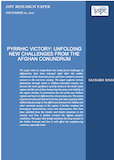Özgür Altun: Turkish Media Mastermind for ISKP Arrested in Pakistan
Ozgur Altun (Abu Yasir al-Turki), a key operative of the Islamic State Khurasan Province (hereafter, IS-Khurasan), was apprehended on June 1, 2025, at an undisclosed location in Balochistan, near the Pakistan-Afghanistan border. His arrest came as a result of a joint operation conducted by Pakistan’s Inter-Services Intelligence (ISI) and Turkiye’s intelligence organization, Milli İstihbarat Teşkilatı (MİT) (Anadolu Agency, June 1).
